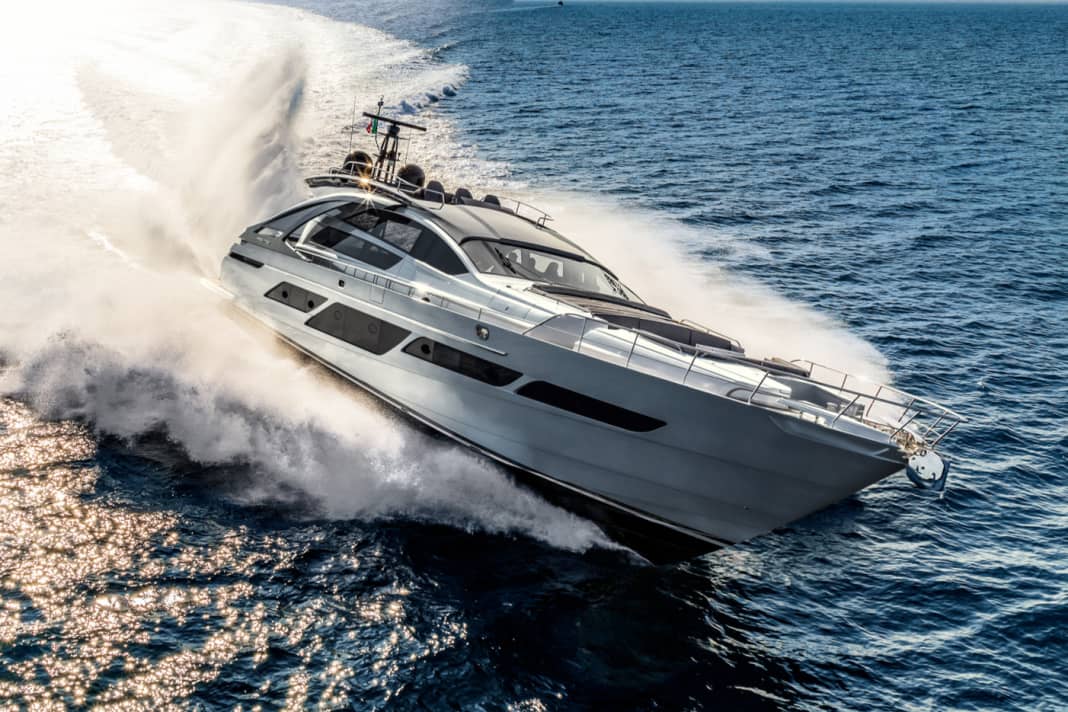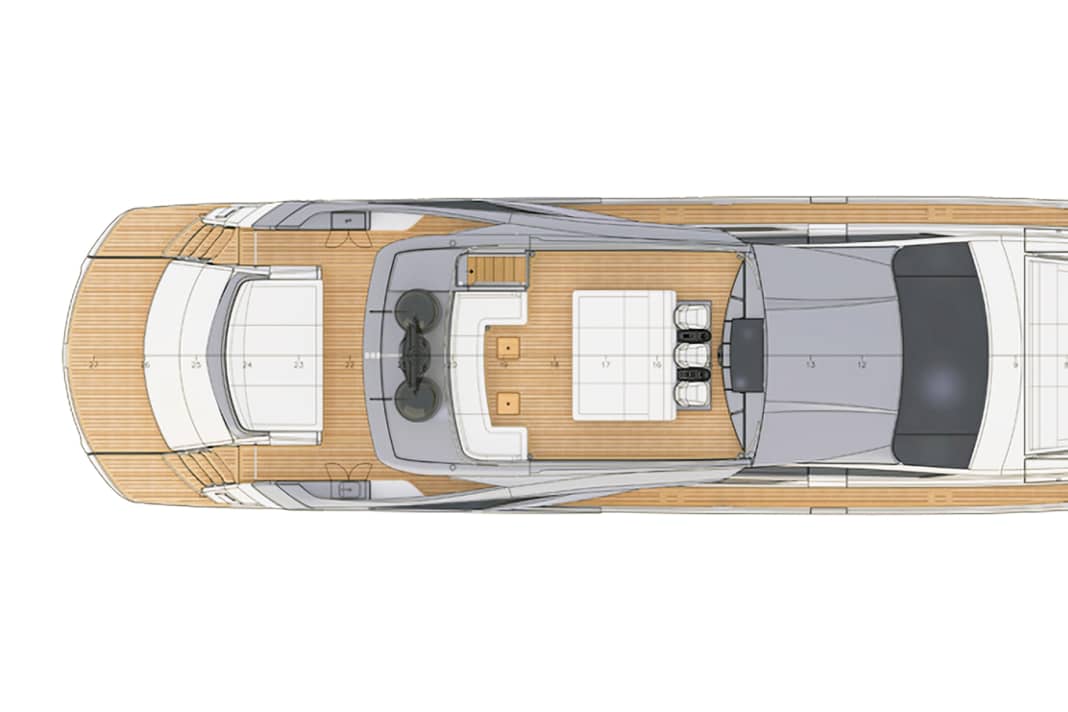Pershing 9X: Between comfort and riot - 28 metres for controlled intoxication
Sören Gehlhaus
· 10.08.2023






The bay of Cannes is deserted in the early morning. The 9X's only sparring partner is a helicopter that appears to be standing still just a few metres off the right flank. The GPS logs 38 knots and communication between the two pilots is intuitive. Photo shoots are not uncommon for Enrico Carbonari. The factory captain is as relaxed as if he were in command of a cable ferry. The 28.14 metre long vessel, whose MTU diesels transmit 3878 kilowatts to a surface drive, obeys every millimetre of steering and thrust. At speeds of 17 knots and above, planing begins and the roostertail, which is up to five metres high, moves with it. The 30 metre long fountain looks like the contrail that a jet plane blows into the ether as a sign of its performance.
Alberto Galassi was right when he never tired of emphasising during the press conference the day before that Pershing captains are actually jet pilots. I am on board construction number five, a demonstration model. The CEO of the Ferretti Group, under whose umbrella Pershing has been operating since 1998, describes the 9X as "a huge ship that looks much smaller. That's what makes it so fantastic!"
After the 5X, the 9X is the second model in the X series, with which Pershing is storming into the future with its usual power and confidence. The Italians are now fulfilling the carbon promise made in the past for cockpit panelling and equipment such as flybridge ladders in structural areas. The shipyard from Mondolfo laminates the 9X extensively in carbon: the hull with vinyl ester resin and a high proportion of GRP, the deck and superstructure with epoxy resin. The hull lines are based on those of the Pershing 92, which in turn evolved from the 90 and 88.
A name like a promise
Pershing - the name is a forward-thinking name that evokes associations of power and speed. Pershing's founder Tilli Antonelli was a professional sailor before founding his own company in 1985. But, how could it be otherwise, the one with the most power on board. On the Italian America's Cupper "Il Moro de Venezia", the Italian brought the winches up to full speed on the grinder. It was named after the American General John J. "Black Jack" Pershing, after whom the MGM-31 Pershing was named during the Cold War: the Pershing missile.
Antonelli awarded the first design contract to Fulvio De Simoni, who went on to become Pershing's in-house designer. The visual resemblance to fighter jets seems to have always been a specification requirement for De Simoni. But never before has the deckhouse resembled the cockpit of a fighter jet as much as on the 9X with its segmented, angular windows. On the other hand, never before had a Pershing fuselage contained such large windows as in the X series.
Calculated risk for Pershing owners
Pershing owners may be a little crazy; for them - attention, cliché! - between lunch in Cannes and partying in Ibiza is only a good five hours at almost full throttle and a 9000-litre tank of fuel. The owners of large Pershings in particular are not racers. "Over 90 per cent leave the command to a captain, but steer themselves as often as possible," says test pilot Carbonari about the speed aficionados. Owners find the calculated risk in the 9X. The thirty-something again: "The smaller Pershings are much more challenging to steer, the trim effort is greater and they are not as stable in the water as the 9X."
Pershing's Maxi Coupé also offers conveniences such as the electronic steering wheel, which automatically returns to the neutral position when released. Or the 500-kilogram gyroscopes of the two Seakeeper stabilisers, which warm up within five minutes of casting off. A flip of a switch puts a prompt end to the slight rocking at speeds of less than five knots. After just one touch of the screen, the Easy-Set system developed jointly with TopSystem takes over, automatically trimming and individually harmonising the performance of the two units.
The interplay between comfort and ruckus is a large part of the 9X's appeal. As hard as a board - it seems as if the carbon is tensing its fibres - the 71.7 tonnes start to move. When the digital rev counter reaches the 1000 rpm mark, the MTU diesels are doing 11.8 knots, burning 168.4 litres of diesel per hour and are additionally cooled with air from then on. From 17 knots, the 9X switches to planing speed.
Padded powerhouse
The bow touches the horizon line as we break the 40-knot mark. Not much can be seen ahead from the cockpit. For those who don't want to rely on the radar, we recommend the optional camera at the bow, in addition to the two in the engine room and the two at the stern. In the cockpit and the adjoining, non-separable saloon, the volume is just under 70 decibels, which is equivalent to a running television and seems to me to be completely quiet in this situation. No jerking, humming or vibrating. The speed can only be guessed at if you take a look at the stern fountain or push your head out of the saloon towards the running deck and do the three-weather taffeta test. Compared to the inner safety of the saloon, the wind feels like a hurricane.
I make my way to the porthole door of the engine room, where the whirring of the turbo engine drowns out the background noise. The captain forbids me to put my senses to another test and climb onto the flybridge. Walking on it is already taboo from 15 knots. 42 knots on the fly felt like 100 km/h in a car without a windscreen. So back to the saloon. My hands search the ceiling in vain for handrails, the steps need to be carefully considered. Owners only enjoy the dining area behind the three pilot seats when the boat is stationary.
When the 9X appears in harbour, bunker operators all over the world rub their hands in glee. At 2000 rpm and 31 knots - with a 1/3 payload and ten people on board - 762 litres of diesel flow through the injection nozzles every hour. By contrast, at 41 knots and 2400 rpm, 1037 litres per hour shoot into the 32 cylinders of each MTU genset. Captain Carbonari circles complex figures in the shallow Golfe de la Napoule, and the turning radius is 100 metres - at 34 knots!
"We have already surfed down waves two and a half metres high at 23 knots," Carbonari reports on one of his ferry trips, during which the range is likely to have increased significantly due to fuel savings. The Pershing engineers put it at 300 nautical miles at 38 knots. With both engines running one after the other and travelling at ten knots, the range climbs to 1000 nautical miles.
Tried and tested from Poltrona Frau
The cockpit resembles that of an F-35 fighter jet with its three 24-inch Simrad touchscreens, the left one of which can be lowered. The last analogue bastions are the compass and the ignition keys. When activating the two engines, the palm of the hand rests on a carbon fibre plate, which in turn is encased in black leather from Poltrona Frau. The cockpit design is the masterpiece that crowns the ten-year collaboration with the Italian furniture multinational. This consistency has resulted in a pleasing styling of all living areas with wenge wood and grey leather, to which all previous 9X owners have made only marginal changes.
I access the lower deck living areas via the companionway to the right of the helm. The layout provides plenty of room for manoeuvre here: There are either three double guest cabins, predestined for family use, or a double cabin to port, a dinette to starboard and the VIP suite in the bow. Below deck, creamy white fluffy carpet massages my feet, while continuous LED strips on the ceilings caress the eyes. Light grey leather upholstery surrounds the beds for safety during the night journey. The snakeskin-covered sideboards can be found in the midships owner's cabin and upstairs in the saloon, just as the whitewashed oak floor adorns the saloon and owner's bathroom. In this version, this is divided into two separate areas, one of which can be replaced by a walk-in wardrobe in another option.
The beige-coloured chaise longue on the starboard side - which rests on stainless steel feet in front of black wengé panelling - has a rather sculptural character, but comes to life as soon as the oval porthole in the window above is opened. The four hull windows create a glass surface of 15 square metres per side. The galley, equipped with Miele appliances, is located between the two crew quarters on the aft lower deck and can be reached via the saloon or a ladder leading to the running deck.
Captain Carbonari manoeuvres the 9X into the pits with just one engine and the classic wheel and ZF lever. The variant in docking mode is probably more common, when the Xenta joystick controls both the diesel engines and the bow and stern thrusters synchronously and electro-hydraulically. Then the 9X even turns on the spot. In the end, the question remains: Does comfort-enhancing technology rob the beast of its magic? Not necessarily. If you want to feel the raw power of the 9X, switch off the Easy-Set system, which is included in the starting price of 7,150,000 euros. Or don't order the two gyro stabilisers and save a quarter of a million euros. The 3.85 metre long Williams tender and a Sea-Doo Spark - both part of the standard package - slide out of the stern like the Pershing 92. The difference to the 9X: in its case, we should rather call the garage a hangar.
Technical data
- Length over everything:28,14 m
- Width:6,23 m
- Depth:1,65 m
- Displacement (empty):68 t
- Material:GRP carbon
- Motor:2 x MTU 16V 2000 M96L
- Engine power:2 x 1939 kW
- Speed (max.):42 kn
- Speed (travelling):38 kn
- Fuel:9000 l
- Consumption @ 31 kn:762 l/h
- Range:380 nm @ 38 kn
- Navigation:Simrad
- Bow thruster:1 x 30 kW
- Gyro stabiliser:2 x Seakeeper 9
- Tender:Williams Turbojet 385
- Styling:Fulvio De Simoni
- Interior design:Fulvio De Simoni
- Construction:Ferretti Group
- Design category:CE "A", RINA
- Shipyard:Pershing, 2017
- Dealer:Sieckmann Yachts





